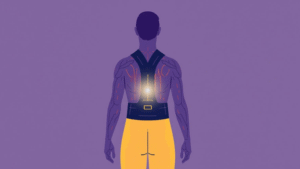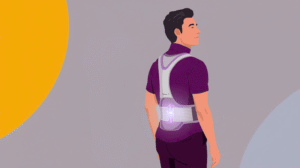You finally make it to your desk, coffee in hand, and ready to tackle your day. The sound of your computer powering on, the screen glowing, and your freshly created to-do list are all that await. Before you know it, maybe only 30 minutes in, there it is, that familiar ache creeping into your lower back. This, my friends, is something that most working adults are dealing with every day.
As hard as we may try, it does not take long for sitting a long time to end in discomfort and pain. You may assume this is because you are aging or you have an old injury, but in the majority of cases, it is due to what is known as posture fatigue [1]. It is not like the sore muscles we feel after a workout, this fatigue creeps up on us, almost unnoticed, and it takes hours for our body to let us know it’s there!
What Is Posture Fatigue?
Understanding Posture Fatigue
Posture fatigue refers to the discomfort and strain that develop when your body holds a static sitting position for too long. Think of it as a “silent stress” on your muscles, joints, and spine. Even if you’re sitting perfectly upright at first, over time, gravity and your body’s natural tendency to relax take over. Muscles that support your spine, like your core and back muscles are forced to work continuously to maintain that stillness. Without breaks or movement, these muscles tire out, leading to the stiffness, aches, and fidgeting you feel [1].
Why It Happens So Quickly
You might wonder: Why can’t I sit for even half an hour without feeling pain? The answer lies in how our bodies are designed. Humans are built to move. Our spine, joints, and muscles thrive on motion and variation. But sitting for prolonged periods locks you into a position that doesn’t allow this natural movement.
Here’s what’s happening:
- Overworking certain muscles: Muscles in your lower back, shoulders, and neck stay contracted to keep you upright. This constant tension eventually exhausts them [2].
- Underusing others: Your glutes, deep core muscles, and even your legs become inactive, which throws off your posture balance and forces some muscles to overcompensate.
- Reduced blood flow: Sitting compresses blood vessels in your hips and thighs, limiting oxygen delivery to your muscles. Over time, this leads to a quicker buildup of lactic acid and that telltale burning, aching sensation.
- Poor spinal alignment: Even small posture slips, like slumping your shoulders forward or rounding your lower back put more pressure on the spinal discs, leading to discomfort.
What Are the Common Causes of Posture Fatigue?
Poor Ergonomics
A poorly designed workstation can force the body into awkward and unnatural positions, which lead to posture fatigue. A monitor that is too low can cause to you bend your neck downward causing strain in your neck and upper back. A chair without good lumbar support can cause you to slouch and exert extra pressure on the lower spine [3]. Even minor details, such as reaching a keyboard too far away or sitting on a chair too high from the desk can increase stress on your joints and muscles. These constant compensations create a spiral of tension and discomfort which leads to posture fatigue.
Muscle Imbalances
When muscles are tight and others have biased a weakening response, it is when the other muscle groups are statically contracted and/or overused for extended periods of time that good posture becomes disrupted. It is through prolonged sitting and inactivity that creates this imbalance. When we are seated, for example, the hip flexors are tightened or in a shortened position while at the same time the glutes and core, which are not being engaged enough, are undergoing a weakened state [4]. This imbalance leads to an anteriorly tipped pelvis thereby leading to the spine moving out of its natural alignment. Subsequently as this imbalance looms over time, the muscles of the back and neck have to work harder to maintain stability resulting in fatigue and pain.
Weak Core Muscles
Your core does not only have to do with abs. It has to do with deep stabilizing muscles that go around your spine and pelvis, they called the transverse abdominis, multifidus, and obliques. They act as a natural “corset” to actively stabilize your spine during static and dynamic movements. if they are weak or inactive, which is easy to do seating all day at your desk job with sedentary lifestyle habits, your body has no choice but to rely mainly on passive structures (like ligaments and spinal discs) instead. this reliance on passive structures allows for quicker muscle fatigue, poor spinal alignment and, then, gets to the typical symptoms of posture fatigue: backache, stiffness, and nerve irritation.
Inactivity and Sedentary Lifestyle
Long-term inactivity does more than just weaken your muscles, it also reduces blood flow and the delivery of nutrients to the muscle tissue and discs in your spine. When blood flow slows down to muscle tissue, your muscles could not deliver the oxygen and nutrients leading to fast muscle fatigue and too much lactic acid [6]. If inactivity is long lasting, the body can develop micro injuries in the muscles and tendons that can make any discomfort last a long time. It can be even worse than that, you can develop structural changes to your spine with long term inactivity reducing disc degeneration or even loss of your natural curvatures of the spine; if you are not able to overcome your discomfort from your posture there could be long lasting issues.
How Does Sitting Affect Your Spine and Muscles?
Pressure on the Spine
Sitting adds pressure on the lumbar discs, the shock absorbers of the spine, compared to standing up or lying down [3]. The pressure will get worse if sitting in a poor posture such as slouching and leaning forward, which put the center of the body’s weight even further away from the spine and takes the lumbar spine out of its natural curve. All of that pressure and position increases the stress on the intervertebral discs. The higher the load placed on the intervertebral discs over time, the greater the risk of them compressing or even herniating [3].
In addition to compressing the lumbar discs, prolonged sitting flattens the lower portion of the spine, which is known as the lumbar region of the spine. Flattening the lumbar curve increased stress on the vertebral joints and ligaments which is another reason you might be getting discomfort or stiffness in your lower back area.
Impact on Blood Flow and Muscles
When you sit for an extended period of time, circulation is inhibited especially in the lower parts of the body as the hip flexor muscles are in a shortened position and the blood vessels are under compression [7]. Less circulation can deprive the muscles of oxygen and nutrients and cause them to fatigue faster and recover slower.
So what happens is that the lack of blood flow and oxygen creates a perfect storm of discomfort and, if breaks and movement are not regularly practiced, may lead to potentially serious health issues like deep vein thrombosis (DVT) in certain populations.
Postural Stress and Muscle Fatigue
Sitting in a fixed position is taxing on some muscle groups such as the lower back muscles (erector spinae), shoulders, and neck[7]. On a cellular level, unlike dynamic movement, muscle loading during sitting is static; the muscles cannot contract and relax in the natural way they would with dynamic motion, and the way they are loaded is using the same muscle groups in a prolonged and unchanged way with no alleviation for longer than what nature intended.
As you are sitting, these muscles in a static state become fatigued and they begin weakening, so they are less effective at supporting your spine. It certainly increases your discomfort but also creates a cycle of poor posture and repetitive muscular exertion that goes on for hours, possibly leading to chronic pain and lessened exercise performance.
What Are the Signs You’re Experiencing Posture Fatigue?
Physical Symptoms
- Dull ache in the lower back
- Tightness in the neck and shoulders
- Stiffness after standing up
- Frequent shifting or fidgeting to find a comfortable position
Early Warning Signs to Watch For
- Increased fatigue during the day
- Difficulty concentrating
- Headaches
- Numbness or tingling in the legs or feet
How Can You Prevent Back Pain from Sitting?
Correct Sitting Posture
- Keep feet flat on the floor
- Knees at or slightly below hip level
- Back straight with shoulders relaxed
- Use lumbar support to maintain the natural curve of the spine
Desk Ergonomics Tips
- Position the monitor at eye level
- Keep the keyboard and mouse within easy reach
- Ensure the chair supports the lower back
- Use a footrest if necessary to maintain proper leg positioning [3]
Stretching and Microbreaks
Incorporate short breaks every 30 minutes to stand, stretch, or walk. These microbreaks can alleviate muscle tension and improve circulation [7].
Strengthening Core and Postural Muscles
Engage in exercises that target the core, such as planks, bridges, and pelvic tilts. Strengthening these muscles supports better posture and reduces fatigue [5].
What Tools and Solutions Can Improve Sitting Posture?
Ergonomic Chairs and Cushions
Investing in ergonomic chairs that come with adjustable lumbar support, adjustable seat heights, and adjustable armrests are great at improving your posture and enhancing comfort [8]. A high-quality ergonomic chair ensures that your weight is distributed evenly in a manner that preserves the natural curves of your spine and reduces pressure on sensitive parts of your body. Ideal features to look for in an ergonomic chair are a contoured seat pan, adjustable tilt tension, and a headrest to allow neck support if necessary.
In addition to chairs, ergonomic cushions and lumbar rolls are fantastic for enhancing your support needs while seated, particularly, if you will be sitting on standard office chairs. Memory foam, and/or, contoured ergonomic cushions that provide targeted pressure relief while encouraging proper posture can allow you to sit in comfort for longer periods of time without experiencing overload fatigue and continued issues with posture.
Standing Desks and Adjustable Workspaces
Switching between sitting and standing during the day can relieve stress on your spine and improve your posture. To switch from sitting to standing and vice versa, we have standing desks or sit-stand converters to enable you to take advantage of this flexibility. Research has supported that varying your posture (even for a few minutes) helps relieve fatigue, increase blood flow, and engage your core [9].
If you do not have a standing desk, you can construct a temporary elevated surface to set your laptop or monitor to allow you to stand for short periods. You can also use an anti-fatigue mat when standing to provide more comfort and stability.
Apps and Reminders for Movement
In a world driven by digital technology, many features of technology can be invaluable when it comes to dealing with posture fatigue. There are countless apps and wearables aimed specifically at reminding you to stand, stretch, or adjust your posture. For instance, you could use an app like Stand Up !, or Stretchly, and set it to send you gentle reminders to stand, stretch, or take a quick break every 30 to 60 minutes.
Regular movement breaks are imperative to combat muscle stiffness and to promote circulation, both of which will assist you in standing with better posture for longer periods of time during your busy day. Simple consistent movements can go a long way in eliminating cumulative load on your muscles and spine.
When Should You Seek Professional Help?
- Chronic Pain Indicators: If back pain persists despite ergonomic adjustments and regular movement, it may indicate underlying issues that require professional evaluation.
- Physiotherapy and Posture Training Options: Physical therapists can provide personalized exercises and interventions to address specific postural problems and alleviate discomfort.
Conclusion
Posture fatigue is a common issue in today’s sedentary work environments, but it’s not insurmountable. By understanding its causes and implementing proactive strategies, like ergonomic adjustments, regular movement, and strengthening exercises, you can alleviate discomfort and promote long-term spinal health.
Frequently Asked Questions
1. Can poor posture cause long-term damage to the spine?
Yes, chronic poor posture can lead to structural changes in the spine, including disc degeneration and nerve compression, resulting in long-term pain and mobility issues [6].
2. Are ergonomic chairs worth the investment for back pain?
Absolutely. Ergonomic chairs are designed to support the spine’s natural curves, reducing strain and preventing discomfort during prolonged sitting [8].
3. Can a standing desk help with posture fatigue?
Yes, alternating between sitting and standing can reduce muscle fatigue and promote better posture, making sit-stand desks a valuable tool in combating posture-related discomfort [9].
4. When should I see a doctor for back pain from sitting?
If you experience persistent pain that doesn’t improve with ergonomic changes and regular movement, it’s advisable to consult a healthcare professional to rule out underlying conditions.
References
- Atlanta Brain and Spine. (n.d.). Ergonomic desk chairs and back pain. Retrieved August 22, 2025, from https://atlantabrainandspine.com/
- Healthline. (2022). Lower back pain when sitting. Retrieved August 22, 2025, from https://www.healthline.com/health/lower-back-pain-when-sitting
- MS Trust. (n.d.). Core muscles and your posture. Retrieved August 22, 2025, from https://mstrust.org.uk/a-z/core-muscles-and-your-posture
- National Center for Biotechnology Information. (2015). Sitting and low back pain. Retrieved August 22, 2025, from https://www.ncbi.nlm.nih.gov/pmc/articles/PMC/
- PubMed. (2013). Microbreaks and muscle fatigue at workstations. Retrieved August 22, 2025, from https://pubmed.ncbi.nlm.nih.gov/
- UCLA Health. (n.d.). Ergonomics and proper posture for prolonged sitting. Retrieved August 22, 2025, from https://www.uclahealth.org/
- UCLA Health. (n.d.). Ergonomics for spine health. Retrieved August 22, 2025, from https://www.uclahealth.org/
- U.S. National Library of Medicine. (2018). Core muscle strength and posture. PMC – PubMed Central. Retrieved August 22, 2025, from https://www.ncbi.nlm.nih.gov/pmc/
- U.S. National Library of Medicine. (2020). Sit-stand workstations and musculoskeletal health. PMC – PubMed Central. Retrieved August 22, 2025, from https://www.ncbi.nlm.nih.gov/pmc/























